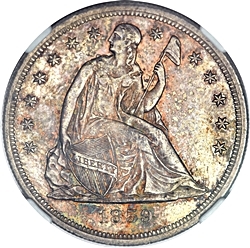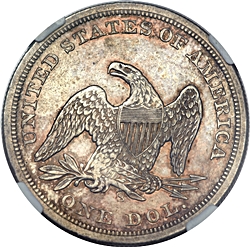 |
1859-S
 

|
 |
General Comments
1859-S is a rare date in the Liberty Seated dollar series. The mintage was low, and many were exported to the orient.
Despite this the date is available with patient searching, in some cases more so than the mintage would indicate.
|
| |||||||||||||||||||
1859-S Die Marriages
Two obverse dies were paired with two reverses to strike the two known die marriages. The following table summarizes the known die marriages.
Click the links below to view the details of the die marriages.
Die Marriage |
Rarity |
Obverse Die |
Reverse Die |
Estimated Survivors |
| OC-1 | R2 | 1 | A | 650 |
| OC-2 | R4 | 2 | B | 150 |
We note that Breen (reference 20) listed two 1859-S varieties. Breen 5461 was described as “normal date”. Breen 5462 was the “repunched 18”. He rated Breen 5462 as “extremely rare”. As you will see in the following sections both the known die marriages are Breen 5462. They exhibit the repunching in early states. Evidence of the repunching disappears as the dies wear and are polished. Examples with clear repunching are scarce but not rare. They can be easily found with patient searching.
1859-S Emission Sequence
No dies were shared between the two known die marriages, so there's no way to conclusively identify the emission sequence.
Emission Order |
Die Marriage |
Comments |
| 1 | OC-1 | Sequencing of the two known die marriages is arbitrary. |
| 2 | OC-2 |
1859-S Quick Finder Chart
The two reverse dies are very similar, but the obverse date position allows quick attribution.
Die Marriage |
Obv Die |
Rev Die |
Right |
Keys |
| OC-1 | 1 | A | L QTR | Obverse: Left date. 1 aligns 4-2.5. RB of 1 is L QTR. 18 is repunched in early die states, but this is the case
for both dies, so it's not a characteristic that should be used for attribution. Reverse: Mintmark position is virtually identical for both dies. Most OC-1 examples exhibit numerous reverse die cracks. |
| OC-2 | 2 | B | B | Obverse: Right date. 1 aligns 4-4.5. RB of 1 is B. 18 is repunched in early die states, but this is the case
for both dies, so it's not a characteristic that should be used for attribution. Reverse: Mintmark position is virtually identical for both dies. No examples of OC-2 with reverse die cracks have been seen. |
| Photo credits:
Obverse and reverse full photos: 1859-S NGC MS63, ex. Gene Gardner, from the Heritage archives. |
